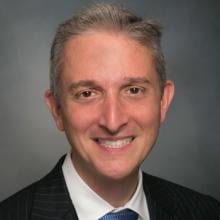For more than eight decades, The Permanente Medical Group has operated under a model rooted in value-based care, contracting directly with the health plan to receive a fixed payment in exchange for managing the health of a defined patient population. That model is still central today—and has continued to evolve in tandem to meet the often changing, and usually complicated, needs of patients and physicians alike.
Unlike traditional fee-for-service models that may not adequately support patient care coordination and can lead to fragmentation in the delivery of care, The Permanente Medical Group’s structure prioritizes prevention and resource optimization.
“These were the principles when the medical group was founded in 1948,” said Stephen Parodi, MD, executive vice president of The Permanente Federation and The Permanente Medical Group, which is a member of the AMA Health System Program. That program provides enterprise solutions to equip leadership, physicians and care teams with resources to help drive the future of medicine.
“Our physician-led organization has developed comprehensive care models that allow for integration between primary care, specialty care, inpatient care and outpatient care. It is all designed to provide the best preventive care possible. But if disease occurs, we also have highly efficient approaches to taking care of patients,” added Dr. Parodi, an infectious diseases physician who is also vice chair for the AMA Integrated Physician Practice Section Governing Council.
Several system-wide shifts have occurred since 1948, especially involving the adaptation of technology. More recently in the early 2000s, the group renewed its focus on high-quality care through population health management programs aimed at improving Healthcare Effectiveness Data and Information Set (HEDIS) measures.
“Whether it's eye exams, kidney health exam evaluation, or statin therapy for our patients with diabetes, thanks to our population health management programs we're now in the top 5% of all commercial plans in the country,” he said. “We’re also in the top 10% nationally for high blood pressure.”
By prioritizing prevention and early intervention, Kaiser Permanente members in California and the Mid-Atlantic Permanente Medical Groups are seeing tangible improvements in outcomes.
“We've got an entire sepsis management program in place that goes upstream into the emergency departments and into our hospital systems,” he said. “Then if the patient has to go to the ICU, we have protocols in place that have been vetted and refined by our researchers, as well as the clinicians in the emergency department, hospitalists and critical care physicians. The physicians are co-designing the protocols that are in place.”
Fighting burnout with adaptive technology
The Permanente Medical Group also recognizes that healthy physicians are essential to provide the best care for patients. Teams have been working on ways to make health care practice more sustainable in order to keep physicians and other health professionals at the medical group.
“We hope they stay with us for 30 years over the course of their entire career,” said Dr. Parodi. “But for that to happen, they can’t burn out.”
To address this, they pioneered the use of ambient scribe technology. This is an augmented intelligence (AI)—often referred to as artificial intelligence—tool that is now deployed across more than 25,000 physicians in the Kaiser Permanente system. The tool transcribes notes during doctor appointments, significantly reducing administrative workload and allowing doctors to give more focus directly to their patients.
“Physicians who are fully utilizing it are saving on average one to two hours a day on documentation,” said Dr. Parodi. “Analysis this March showed that 47% of their patients are actually saying their doctors spent less time looking at their computer and 56% said that the ambient AI scribe had a positive impact on the quality of their visit.”
This technology has made a significant impact with 84% of physicians reporting improved patient interactions, and 82% saying their work satisfaction has improved.
“The way that you can implement that kind of technology as quickly as we did is because we've got doctors talking to doctors,” said Dr. Parodi. “They are then co-designing what that AI product looks like, and then actually continuously improving it.
“It's so exciting to see that when you involve physicians and physician leadership in the design of these programs, how effective they can be,” he added.
As the leader in physician well-being, the AMA is reducing physician burnout by removing administrative burdens and providing real-world solutions to help doctors rediscover the Joy in Medicine™.
Anticipating crises before they happen
Innovation doesn’t stop with documentation. The Permanente Medical Group has also integrated advanced predictive technologies into their hospitals.
“We have utilized data that we have within the electronic health records to predict which patients are at risk for clinical deterioration within the next 24 to 48 hours,” said Dr. Parodi. “We have used augmented intelligence to help that program automatically monitor patients. It then sends an alert to a response team in the hospital saying, ‘Hey, this person might be at risk for clinical deterioration.’”
Initially, these alerts were only triggered during “Code Blue” scenarios. Now, care teams can intervene before a patient is in a critical state.
“It's really transformed how we take care of patients. And it actually has reduced mortality in those patients,” he said.
In stroke cases, timing makes a demonstrable difference in patients’ outcomes, particularly starting the right treatment as quickly as possible after a stroke happens. To address that, Kaiser Permanente implemented a telestroke program nine years ago to speed up diagnosis and treatment.
“When a patient comes into the emergency department, the emergency medicine physician and team are able to telemedicine in a stroke specialist on the spot,” said Dr. Parodi. “They can make determinations and do the examination that's needed to determine whether or not a patient needs a clot-busting medication administered.
“And we worked out the protocols for making sure that the appropriate advanced imaging is done so that they can make those decisions within minutes,” he added.
But with all of the technological additions to the processes, physicians still have autonomy to make decisions based on individual patients’ needs. Preventive measures essentially create a pipeline of key information for the physicians and their teams to make the best possible care decisions for their patients.
From AI implementation to EHR adoption and usability, the AMA is fighting to make technology work for physicians, ensuring that it is an asset to doctors—not a burden.
Making care more accessible
Patient engagement is another pillar of value-based care. Using technology to enable patients to play a more involved role in the exchanges they have with physicians and care teams can lessen burdens on both sides, even if it takes patients time to acclimate to new tools. Through electronic and asynchronous communication, for example, The Permanente Medical Group’s patients can send their questions in to doctors and medical teams.
“We've developed more and more protocols using what we call e-visits, which allows us to take care of the patient's problem on the first contact—what we call point of contact resolution,” said Dr. Parodi. “So, if you’re emailing in or answering some questions online about your condition, and let’s say it’s a urinary tract infection, we’ve got protocols in place where we can ideally diagnose and then get a prescription to you at the first point of contact, even if that's electronically.”
That approach is essential given the projected physician shortage, especially in primary care.
“As a nation, we're facing a critical physician shortage, particularly in primary care over the next 10 years,” said Dr. Parodi. “We have to think about how we can have technology allow us to provide that same high-level care … but to a broader and aging population with fewer clinicians.”
Building effective value-based systems
Making value-based care work well for patients and physicians takes careful collaboration. But medical groups and payers must align goals and expectations.
“If we're going to have an arrangement or the medical group's responsible for, say, cardiovascular disease, we have an agreement about what level of hypertension control we're going to expect for that population of patients,” said Dr. Parodi. “What level of cholesterol control is another one. And those are the discussions that we have as an integrated system at Kaiser Permanente. Every year, we actually agree on these levels of achievement that we expect to get for a given patient population.”
That collaboration must be informed by data and an understanding of patient needs which allows for appropriate risk adjustment.
“In other words, relative to the rest of the U.S. population, this is how sick our attributable patients are, and this is what we think we can achieve in a given year,” Dr. Parodi added.
With a combination of transparency, trust and collaboration, value-based care can happen across a broader range of physicians and institutions.
“You have to have transparency of what we think we're achieving with the patient population and what information we’re getting from the electronic health record,” said Dr. Parodi. “I can't emphasize enough the importance of collaboration that occurs between the different specialties, and really the different medical centers, as well to achieve optimal results.
“It's really starting with and picking what are the biggest potential opportunities and targets for a given set of patients who you're responsible for,” he added. “It may be focusing on a certain few conditions that you can agree on with your insurance partners that you're contracting with and saying, ‘OK, let's start here.’”
Looking ahead
The momentum for value-based care is growing across the country.
“In California, we have seen an evolution of even the Medicaid program, where the state has basically said within the next few years, they want a full transition from Medicaid fee-for-service to Medicaid managed care arrangements, where again, there are incentives built into performance around HEDIS measures and other state-specific measures,” said Dr. Parodi. “There are other states that are looking into those arrangements as well.”
As value-based care expands, The Permanente Medical Group continues to demonstrate how integration, innovation and physician leadership can lead to healthier outcomes and more satisfying careers.
“Value-based care for Kaiser Permanente and for the physicians who are practicing within the system has allowed us to drive toward better patient-centered outcomes,” said Dr. Parodi. “I can speak personally as a physician who's been here 22 years that it is a fulfilling effort. It has allowed us to collaborate as clinicians with each other, across geographies and across specialties, in a way that is very special and extremely fulfilling.”
Learn more with the AMA about value-based care, including ways to improve data sharing and best practices for payment methods.





